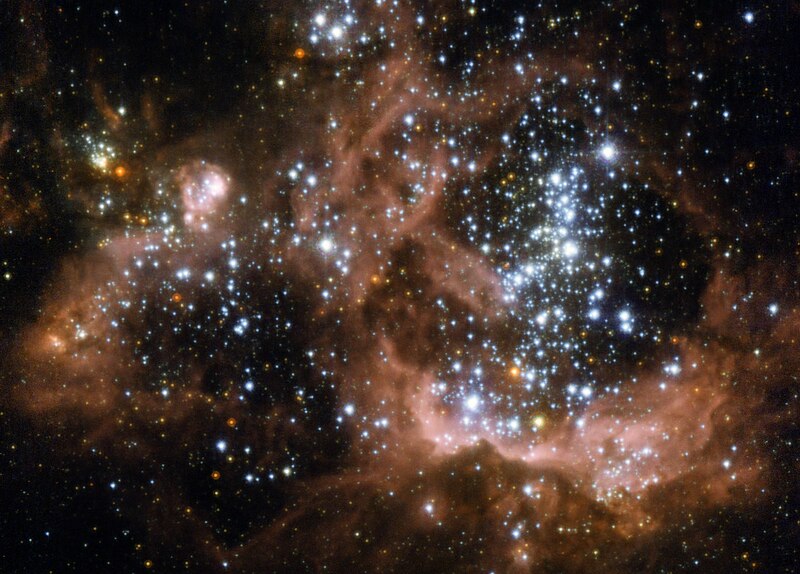File:M33.tif

Original file (1,254 × 900 pixels, file size: 2.62 MB, MIME type: image/tiff)
Captions
Captions
Summary
[edit]| DescriptionM33.tif |
English: A billowing cloud of hydrogen in the Triangulum galaxy (Messier 33), about 2.7 million light-years away from Earth, glows with the energy released by hundreds of young, bright stars. This NASA/ESA Hubble Spare Telescope image provides the sharpest view of NGC 604 so far obtained.
Some 1500 light-years across, this is one of the largest, brightest concentrations of ionised hydrogen (H II) in our local group of galaxies, and is a major centre of star formation. The gas in NGC 604, around nine tenths of it hydrogen, is gradually collapsing under the force of gravity to create new stars. Once these stars have formed, the vigorous ultraviolet radiation they emit excites the remaining gas in the cloud, making it glow a distinct shade of red. This colour is typical not only of NGC 604 but of other H II regions too. Although it is part of Messier 33 this object is so bright and prominent that it was given its own NGC number. The fierce ultraviolet radiation released by the stars that give these hydrogen clouds their distinctive glow is also the cause of their uneven appearance and eventual disappearance. The radiation and winds blowing from the surface of these stars gradually erode the cloud they formed from, causing the gases to slowly disperse. The complex structure of NGC 604, with irregular bubbles and wispy filament-like structures alongside denser, redder areas is due to the same forces that will eventually make the cloud disappear. The blister-like cavities show areas of stronger erosion of the cloud. While these areas appear dark in this photograph, they shine brightly at X-ray wavelengths. This image was created from images taken using the High Resolution Channel of Hubble's Advanced Camera for Surveys. It is a composite of images taken through a total of seven different filters spanning a huge range of wavelengths — from 220 nm in the ultraviolet all the way up to the near infrared at one micron. The field of view is about 31 by 22 arcseconds. |
| Date | |
| Source | http://www.spacetelescope.org/images/potw1019a/ |
| Author | ESA/Hubble and NASA |
Licensing
[edit]- You are free:
- to share – to copy, distribute and transmit the work
- to remix – to adapt the work
- Under the following conditions:
- attribution – You must give appropriate credit, provide a link to the license, and indicate if changes were made. You may do so in any reasonable manner, but not in any way that suggests the licensor endorses you or your use.
File history
Click on a date/time to view the file as it appeared at that time.
| Date/Time | Thumbnail | Dimensions | User | Comment | |
|---|---|---|---|---|---|
| current | 14:19, 22 September 2010 |  | 1,254 × 900 (2.62 MB) | Jmencisom (talk | contribs) | {{Information |Description={{en|1=A billowing cloud of hydrogen in the Triangulum galaxy (Messier 33), about 2.7 million light-years away from Earth, glows with the energy released by hundreds of young, bright stars. This NASA/ESA Hubble Spare Telescope i |
You cannot overwrite this file.
File usage on Commons
There are no pages that use this file.
File usage on other wikis
The following other wikis use this file:
- Usage on af.wikipedia.org
- Usage on ca.wikipedia.org
- Usage on cs.wikipedia.org
- Usage on de.wikipedia.org
- Usage on en.wikipedia.org
- Usage on fr.wikipedia.org
- Usage on he.wikipedia.org
- Usage on ko.wikipedia.org
- Usage on uk.wikipedia.org
- Usage on zh.wikipedia.org
Metadata
This file contains additional information such as Exif metadata which may have been added by the digital camera, scanner, or software program used to create or digitize it. If the file has been modified from its original state, some details such as the timestamp may not fully reflect those of the original file. The timestamp is only as accurate as the clock in the camera, and it may be completely wrong.
| Width | 1,254 px |
|---|---|
| Height | 900 px |
| Compression scheme | LZW |
| Pixel composition | RGB |
| Orientation | Normal |
| Number of components | 3 |
| Number of rows per strip | 69 |
| Horizontal resolution | 72 dpi |
| Vertical resolution | 72 dpi |
| Data arrangement | chunky format |
| Software used | Adobe Photoshop CS3 Windows |
| File change date and time | 14:39, 10 August 2010 |
| Color space | Uncalibrated |